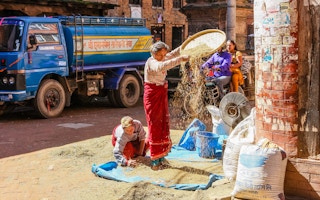Thousands of farmers in Nepal’s fertile southern plains, the country’s rice bowl, face a double whammy of a fertiliser shortage and inadequate monsoon rains.
This is likely to affect production of the country’s staple grain, which also contributes around a quarter of the country’s gross domestic product and provides employment of at least six months for a large proportion of the population.
“Paddy has been planted only in around 75 per cent of the fields as of end of July,” said Suma Karki, a spokesperson for the Department of Agriculture. “Last year this time, the figure was around 88 per cent.”
The monsoon clouds, which originate in the Bay of Bengal in the Indian Ocean, are obstructed by the Himalayan mountain range when they try to move north.
They then form a low-pressure band, shedding their moisture in the form of rain in the foothills of the mountains as well as the Gangetic plain that runs through Nepal, India and Bangladesh. The band, known as the monsoon trough, moves between the foothills of mountains in the north and the Indian plains in the south bringing rain wherever it goes.
“This monsoon season, the trough has remained in the Indian plains for a longer period than we’d expect it to,” said senior government meteorologist Indira Kandel. This is why Nepal’s southern plains haven’t received adequate rains for rice farmers this year, she added.
“
This monsoon season, the trough has remained in the Indian plains for a longer period than we’d expect it to. It would be too early to say that the heat waves had anything to do with the behaviour of the monsoon trough. But we can’t rule out that possibility.
Indira Kandel, senior government meteorologist, Nepal
The monsoon rains account for 60-90 per cent of Nepal’s total annual precipitation, and are crucial for the farmers who grow rice on around 1.4 million hectares (3.5 million acres) of land, 75 per cent of which lie in the southern Terai plains. Most of the farmers are dependent on the rains as the irrigation system in the country can’t cater to all their needs.
“Due to lack of adequate rain, the rice fields have developed cracks and the plants have dried up,” said Ranju Sharma, a farmer from the rural municipality of Katahari in Nepal’s Morang district, near the border with India.
Farmers such as Sharma are already under stress as large numbers of Nepali workers seek jobs abroad in India and the Middle East. This makes it difficult to plant rice on time as the traditional cultivation practices are labour intensive. In addition, unexpected issues pop up virtually every year that forces the farmers to bear huge losses.
This year, the farmers had anticipated that the main challenge would be a shortage of chemical fertilisers. The government, which used to supply fertiliser to farmers ahead of the monsoon season, failed to do so this year as the fertiliser couldn’t be imported in time. But the lack of rainfall has created more trouble.
“We were already worried that the output would go down this year due to lack of fertiliser, now the rainfall problem has added to our woes,” Sharma said.
The change in rainfall patterns in Nepal’s plains come as record heat waves, attributed to climate change, recently engulfed much of the Northern Hemisphere, including India. “It would be too early to say that the heat waves had anything to do with the behaviour of the monsoon trough. But we can’t rule out that possibility,” Kandel said.
What is known is that a changing climate has changed the long-term precipitation patterns in Nepal. A report by the Department of Hydrology and Meteorology suggests that although the volume of total rainfall hasn’t changed much, the intensity has. This means rainfall patterns have become hard to forecast, and the chances of flash floods have increased.
Many farmers say they still remember all too well the flash floods during last year’s monsoon, just as they were preparing for what they thought would be a good harvest. The monsoon, which typically leaves Nepal in late September, stayed longer last year, bringing unexpected rains in the second week of October. According to government figures, which usually underestimate damages, farmers suffered losses amounting to 11.87 billion rupees ($93 million).
As the monsoon trough moves north again, farmers say they hope it brings adequate rain this time before it heads back south again. “The rains should stop when they are supposed to stop,” Sharma said. “If it doesn’t, we might have to abandon rice farming altogether as we can’t take losses year after year.”
Nepal’s import-dependent economy, which is already under huge pressure due to rising fuel prices, could take another hit if rice production takes yet another major hit this year. The country, which only has sufficient foreign currency reserves to finance around seven months of imports, could face severe problems if the food import bill also rises, economists warn.
This story was published with permission from Mongabay.com.










